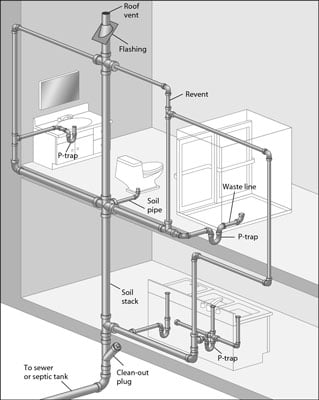Are you currently trying to find resources around Essential Plumbing Vent Pipes: Understanding Their Role?

Correct ventilation in pipes systems is frequently ignored, yet it is crucial for keeping the functionality and security of your home's pipes. Ventilation aids regulate air pressure, stop the build-up of hazardous gases, and make certain the efficient removal of waste. In this guide, we will check out the relevance of appropriate plumbing ventilation, how it works, and the advantages it offers your pipes system.
Exactly How Ventilation Functions in Pipes Equipments
Air Pressure Policy
Correct air flow preserves balanced air pressure within the plumbing system. When water flows through pipes, it displaces air. Without adequate air flow, this variation can create adverse pressure, leading to slow drains or siphoning of water from catches, which can cause unpleasant odors to leak right into the home.
Stopping Sewer Gas Accumulation
One of one of the most essential features of plumbing vents is to avoid sewer gases, such as methane and hydrogen sulfide, from gathering within the home. These gases can position serious health and wellness risks and are very combustible. Vent pipelines allow these gases to escape securely outdoors.
Aiding in Waste Elimination
Air flow assists in the reliable elimination of wastewater by protecting against airlocks in the drain system. When air can move freely with the vents, it permits water and waste to flow efficiently via the pipes, lowering the threat of obstructions and back-ups.
Benefits of Appropriate Ventilation
Improved System Performance
Correctly aerated pipes systems run extra successfully, with fewer clogs, faster draining pipes, and less pressure on the pipes. This performance prolongs the life expectancy of the plumbing system.
Improved Air High Quality
By avoiding sewage system gases from entering your home, proper air flow contributes to far better interior air high quality, making your living setting healthier and more comfortable.
Avoiding Water Damages
Appropriate air flow aids protect against water from being siphoned out of catches, which can bring about sewage system gases getting in the home and causing water damage over time.
Actions to Ensure Correct Air Flow
Consulting Plumbing Codes
Constantly seek advice from local plumbing codes when developing or changing your pipes system. These codes offer the needed guidelines for appropriate venting and ensure your system meets security standards.
Regular Assessment and Maintenance
Normal evaluations can aid determine possible ventilation concerns prior to they end up being major problems. Maintenance jobs, such as cleaning air vent pipelines and checking for obstructions, are necessary for keeping the system in good working order.
Expert Setup
For brand-new installations or significant adjustments, it's wise to work with a specialist plumbing. They have the knowledge to make sure the air flow system is correctly made and set up according to code.
Understanding Air Flow in Plumbing
Ventilation in plumbing refers to the network of pipes that allow air to flow through the water drainage system. These vents offer several purposes, consisting of controling air pressure within the pipes, preventing sewage system gases from going into the home, and aiding in the smooth circulation of wastewater.
Sorts Of Pipes Vents
Key Stack Vent
The major pile air vent, also known as the air vent pile, is the main air vent in a pipes system. It prolongs from the main drain align via the roof, allowing gases to run away and fresh air to go into the system.
Branch Vent
Branch vents link to the primary stack air vent and offer private components, such as sinks, commodes, and showers. These vents make sure that each fixture has sufficient ventilation to function properly.
Air Admission Shutoff (AAV).
An Air Admittance Valve (AAV) is a one-way shutoff that allows air to go into the pipes system without the need for a typical vent pipe expanding via the roofing. AAVs are typically made use of in renovations or locations where installing a typical vent is unwise.
Indicators of Poor Ventilation in Plumbing.
Slow Draining Fixtures.
If your sinks, tubs, or toilets are draining gradually, maybe an indicator of bad ventilation. Poor air circulation can create a vacuum cleaner result, making it tough for water to drain pipes effectively.
Gurgling Seems.
Gurgling audios originating from drains are commonly an outcome of air being drawn through water catches due to negative stress in the pipes. This is a clear indicator of insufficient ventilation.
Undesirable Smells.
Sewage system smells inside your home are a warning that your pipes system is not correctly aerated. This can imply that drain gases are not being properly vented outside, causing possibly dangerous conditions.
Typical Ventilation Mistakes.
Inadequate Vent Sizing.
Utilizing undersized vent pipes can lead to poor air circulation and stress imbalances in the system. It's important to use vents that satisfy the specific needs of your pipes system.
Improper Vent Placement.
Putting vents as well much from the fixtures they offer can lower their performance. Proper placement makes sure that air can move easily and efficiently via the system.
Disregarding Code Demands.
Building regulations provide specific standards for pipes ventilation. Neglecting these codes can lead to a system that falls short to operate correctly and may bring about expensive repair work or health hazards.
Verdict.
Appropriate ventilation is a crucial element of any type of plumbing system, guaranteeing that it works effectively and safely. By understanding the importance of ventilation, acknowledging the indications of inadequate ventilation, and taking actions to preserve your system, you can avoid expensive problems and safeguard your home's air top quality.
4 Things You Should Know About Your Plumbing Vents
What Plumbing Vents Are
Also called a vent stack, a plumbing vent is a vertical pipe attached to your drain line that runs through your roof. The plumbing vent pipe, or plumbing air vent, removes gas and odors from your plumbing system and allows fresh air to enter the pipes, helping the water to flow out of the drain pipes.
What Plumbing Vents Do
Plumbing vents have two basic functions. One of which is to allow unpleasant smelling wastewater and sewer gasses to escape your plumbing system instead of entering your home. Plumbing vent pipes are typically located on roofs, away from windows, to ensure the fumes exit the home completely.
The other function of the plumbing vent is to move fresh air into your plumbing system. This helps move water through every plumbing fixture in your house, like toilets and sink drains. Think of the way in which you need to let a little air into the bottle as you pour soda in order to make the drink flow smoothly.
Different Types of Plumbing Vents
True vent: This is the most common vent option. In simplest terms, a true vent is a vertical pipe attached to your drain line that exits through the roof. They often function as the main vent that other fixtures can connect to. Re-vent pipe or auxiliary vent: Attached to the drain line near specific plumbing fixtures, re-vent pipes run up and over to connect to the main vent. Common vent: Two plumbing fixtures installed on opposite sides of a wall are typically tied into the vent stack using something known as a sanitary cross. Wet vent: This venting option operates as a drain pipe and a vent at the same time. Wet vent drainage systems drain water from one fixture while venting the air from another. Although they’ve been used for over 100 years, wet vent systems have only recently been added to the plumbing code in many areas. If you’re planning on installing one in a bathroom remodel, make sure you check your local code prior to construction. Loop vent: For free-standing fixtures like kitchen island sinks, loop vents are ideal. These vent pipes run under the floor, rise from the P-trap, and create a loop inside the cabinet sink. Air admittance valve: An AAV is a one-way mechanical valve typically installed at the site of the plumbing fixture. AAVs allow venting to occur without having to tie into a larger venting system. They’re ideal for venting fixtures where you aren’t able to easily connect to an existing vent system. Common Plumbing Vent Issues
Although vent pipes typically don’t have water flowing through them, they’re still subject to many typical plumbing issues. For example, clogs are one of the most common problems associated with sewer vent pipes. If your vent pipe gets clogged, all of your plumbing fixtures tied into the vent stack will be affected.
A sink with a slow drain that bubbles and gurgles or a strong sewage smell around your toilet are both indicators that your toilet vent pipe is clogged. Because most vent pipes exit through the roof, old leaves, twigs or even a bird’s nest could be clogging the pipe.
Clogs in your vent pipe system cause a buildup of negative pressure, meaning that water won’t be able to flow out of your home very well. It’s similar to putting your finger over the opening of a straw to trap water inside. When you remove your finger, the water is able to flow out of the straw.
If you suspect you have any blockage in your vent, make sure you have a professional come examine the situation. Left unchecked, a blocked air vent can lead to other costly repairs, like leaks and sediment buildup.
Under Pressure
Pipe vents are essential aspects of a home’s plumbing system. Owning a home means learning about all sorts of things you never put much thought into before. But by understanding as much as you can about the important systems of your home, you can keep those budgets intact and those anxiety levels low.
https://www.homeserve.com/en-us/blog/home-improvement/plumbing-vents/

Do you really like more info about What Are Plumbing Vents and Why Are They Important?? Post a remark further down. We will be pleased to know your reactions about this write up. We are looking forward that you visit us again soon. If you please set aside a second to share this entry if you appreciated it. I love reading our article about Why Plumbing Air Vents Are Important.
Additional Information